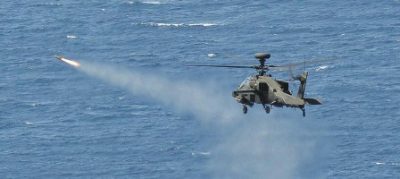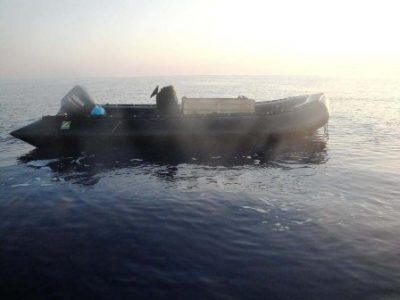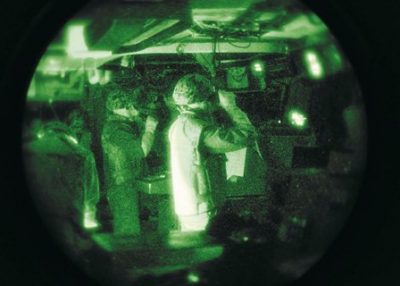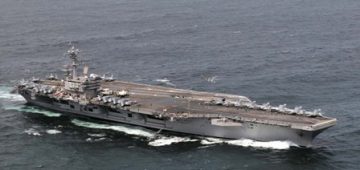LIBYAN SEA WAR EXPLODES
• Carrier-based Attack Helicopter Strikes
• Canadian warship attacked with rockets
• Gaddafi Sends IEDs to sea off Misrata
• British and Canadian Frigates in Gun Fight
• Mines Cleared
• RAF Hits Libyan Navy

THE British assault carrier HMS Ocean and French Navy amphibious aviation ship FNS Tonnerre have been ordered to take up station off the coast of Libya by their respective national governments to launch attack helicopter strikes against Gaddafi regime targets. Lacking a strike carrier with embarked Naval Strike Wing (NSW) GR9 Harriers to conduct Close Air Support (CAS) at the sortie rate necessary to provide greater protection for the civilian population, as authorised under United Nations Security Council Resolution 1973 (UNSCR 1973), the UK government had no choice but to deploy the Ocean, with four Apache Longbow helicopter gunships aboard.
A Ministry of Defence (MoD) spokesperson stated: “Apache has shown how effective it is in Afghanistan, and its use in Libya would only increase the pressure on the regime to end its persecution of the Libyan people.”
The Ocean, which was in the western Mediterranean on the Royal Navy’s Cougar 2011 amphibious task group deployment had just over a week earlier conducted intensive test firings of the Hellfire missile from her embarked Apaches, which are from 656 Squadron of 4 Regiment Army Air Corps (AAC).
Flying low over maritime firing ranges off Gibraltar, the Apaches also tested their 30mm cannons against seaborne targets. A MoD statement of the test firings boasted: “In total, 550 rounds of 30mm and nine radar-guided Hellfire missiles were fired, achieving a 100 per cent strike rate – the first time Hellfire has been launched in the maritime environment.” As veterans of the war in Afghanistan the AAC pilots, their machines and support crews, are combat proven, but flying from a carrier, in the highly corrosive maritime environment is a radically different discipline. It is intended the Apaches will be able to operate day or night. The Commanding Officer of 656 Sqn explained: “Today we proved that Apache can operate effectively from a Royal Navy ship, transporting munitions from the ship’s magazine, aircraft upload, launch, firing and then recovering to HMS Ocean.” The overall boss of the Ocean’s air group, Commander Jol Woodard, which also includes naval helicopters from the Commando Helicopter Force (CHF) told this magazine: “The successful test firings were also a very important step in the development of the UK’s amphibious capability. I have been delighted with the way in which 656 Sqn and their support elements have integrated into the air group as a whole and the success of this whole-ship evolution demonstrates just how potent a truly joint air group can be.”
Over the past decade and more Apaches have flown from Ocean on several occasions, but this is the first time they have deployed overseas in the assault carrier and also on front line operations flying from any warship. Meanwhile, the French, who have stationed their nuclear-powered strike carrier Charles de Gaulle off the Libyan coast for the past two months, have committed eight NH-90 troop transport and four Tiger attack helicopters to operating from the Tonnerre. A French defence source told the Le Monde newspaper: “Using the helicopters of the Tonnerre is a way to get closer to the ground.” The same source told Le Monde, in reference to the French assault ship and the UK’s: “At a distance of some 15 nautical miles from the Libyan coast, just beyond the horizon, these ships will enable their aircraft to carry out raids lasting two hours over cities where pro-Gaddafi forces are mixed among the civilian population.”

MARITIME IED NEUTRALISED
In an alarming turn of events at sea, Gaddafi regime forces left a Rhib containing a massive amount of explosives in the vicinity of NATO naval vessels, going as far as ‘crewing’ the floating Improvised Explosive Device (IED) with two mannequins. This move was spotted when two Rhibs were detected off Misrata, one of them retreating at high speed, leaving the suspect craft behind seemingly stopped dead in the water. NATO warships and helicopters were soon on the scene and it was decided to send an Explosive Ordnance Disposal (EOD) team to investigate. A NATO spokesman explained that members of the EOD team cautiously inspected the drifting Rhib and discovered “a large quantity of explosives, approximately one metric tonne and two mannequins.” The spokesman continued: “In view of the obvious threat posed by the explosives the decision was made to destroy the Rhib at sea. This was carried out by Allied warships using naval gunfire.” The NATO spokesman suggested that the purpose of the craft and its cargo of explosives was “to get mariners to come close to the Rhib, thinking there might be people in distress.” The Gaddafi forces would then “set off the explosives with a potential devastating effect.” The NATO spokesman was very angry about this latest move by Gaddafi’s maritime forces: “One tonne of explosives is a huge amount. This is nothing less than a floating booby-trap meant to kill people or sink ships.” Together with bombardments of Misrata and other incidents at sea it represented “a serious change in tactics by the pro-Gaddafi forces and clearly demonstrates their intent to use their naval assets and naval knowledge to bring even more harm to innocent civilians.”
The spokesman added: “It also demonstrates that pro-Gaddafi forces have the will and desire to strike NATO vessels.”

GUN FIGHT WITH GADDAFI FORCES
A week earlier British and Canadian warships opened fire on small craft attacking Misrata and having chased them off were themselves subjected to fire from shore-based Gaddafi forces. The frigate HMCS Charlottetown and destroyer HMS Liverpool, supported by a French frigate not at the time under NATO control, but acting on French sovereign Rules of Engagement (ROE). As the warships approached, the Gaddafi craft – believed to be armed Rhibs – fled under the cover of fire from anti-aircraft and artillery guns firing from coastal positions. A NATO spokesperson explained: ‘Charlottetown responded with a short burst of machine gun fire and HMS Liverpool also returned fire. Neither warship sustained any damage or injury during this engagement.’
The UK MoD explained that it was feared Gaddafi maritime forces were dropping mines in Misrata harbour, prompting Liverpool and Charlottetown to take immediate action. An MoD statement on the action revealed:
‘A Libyan artillery battery on the coast fired an inaccurate salvo of rockets at HMS Liverpool whereupon she immediately returned fire with her 4.5-inch gun, silencing the shore-based aggressors.’ The captain of the Type 42 destroyer, Commander Colin Williams was full of praise for his Ship’s Company, remarking: “It was very humbling to see my Ship’s Company working so calmly and quietly. There was no jingoism, no shouting, the atmosphere was cool as people went about their jobs.” Cdr Williams provided further insights into how the exchange of fire unfolded: “We had a couple of contacts moving down the coast. The other two ships went in to investigate, and we sent up our helicopter in support. Then [the helicopter and NATO warships] started getting fired on by the [Libyan] vessels and from the shore.” With the ship’s helicopter taking evasive action on coming under fire, the Liverpool let rip with her 4.5-inch gun “We knew we had to defend ourselves,” explained Cdr Williams, “so we laid the 4.5-inch gun on target and fired a round at the shore target.”

SEAFOX DESTROYS MINE OFF MISRATA
The British mine-hunter HMS Brocklesby used a high-tech, cutting edge Seafox system to destroy a mine laid by Gaddafi forces off Misrata. The Hunt Class vessel, a type of warship proven in active mine clearance from the Tanker War of the 1980s, through Desert Storm in 1991 to disposal of WW1 and WW2-era ordnance in the Baltic, used her sonar to locate the mine, which was a mile from the harbour entrance. Brocklesby then sent the Seafox Under Water Mine Disposal System (UWMDS) – a sophisticated Remotely-Operated Vehicle (ROV) – into action. NATO sources suggest the Gaddafi forces’ aim was to disrupt or event halt humanitarian aid shipments to the besieged rebel stronghold, the mine containing over 100 kilograms of high explosives. It was thought it had been dropped by one of the notorious Rhibs that have been causing such trouble in the Libyan littoral. The Brocklesby and another NATO mine-hunter were soon in action again, disposing of further mine threats while overseeing the safe movement of vessels in and out of Misrata.

LIBYAN SHIPS HIT
Having weathered a number of forays by Gaddafi’s naval forces to bombard the besieged rebel port of Misrata and lay mines, NATO decided to address the problem at source. British Tornado strike jets, and aircraft from other nations, mounted an attack on the naval base of Al Khums, which the MoD described as ‘the nearest concentration of regime warships to the port of Misrata, which Colonel Gaddafi has repeatedly attempted to close to humanitarian shipping.’ Two corvettes moored alongside were claimed as hit, while the destruction of a facility where fast Rhibs were being made, again for offensive operations by Gaddafi forces off Misrata, was also destroyed. By May 20, the MoD was claiming that precision strikes by RAF jets and Royal Navy submarines launching Tomahawk Land Attack Missiles (TLAM) had destroyed what it described as ‘330 regime targets’. Of the air raids against Libyan maritime forces Admiral Russell Harding, Deputy Commander of NATO’s Operation Unified Protector said: “Given the escalating use of naval assets, NATO had no choice but to take decisive action to protect the civilian population of Libya and NATO forces at sea.”

CARRIER JETS HAVE A BETTER SORTIE RATE
Falklands War veteran Sea Harrier fighter pilot Sharkey Ward has pointed out the poor sortie rate of British land-based aircraft during the Libya campaign compared with carrier jets. Commenting on a recent newspaper report that ten Typhoon and ten Tornado strike aircraft of the RAF have allegedly flown 500 missions over a period of eight weeks, Cdr War said it equated to less than one mission per aircraft every two days. He added: “The taxpayer should compare this effort with: the ‘mission rate’ achieved by Carrier/Harrier aircraft of the United States Marine Corps – two missions per aircraft per night; the mission rate of the French aircraft carrier – at least one mission per aircraft per day; and the Falklands War Carrier/Sea Harrier mission rate of just under two missions per aircraft per day.” Cdr Ward shot down three Argentinean aircraft during the 1982 Falklands conflict and prior to that had flown F-4 Phantoms from the big carrier HMS Ark Royal in the 1970s. On Libyan air operations he also observed: “These simple statistics show that carrier air power is much more effective than land-based air power for offshore contingency operations – by up to a factor of four.” However, the RAF claims that its precision strikes are having a decisive effect on the battlefield in Libya. During one 36-hour period last month it claimed that its strike jets managed 17 strikes, all of them direct hits.
A coastal radar station near Brega was also destroyed, using a Brimstone missile, a type of weapon originally designed for use against armour.












Comments
Sorry, comments are closed for this item